
The Swedish Academy, founded in 1786 by King Gustav III, is one of the Royal Academies of Sweden. Its 18 members, who are elected for life, comprise the highest Swedish language authority. Outside Scandinavia, it is best known as the body that chooses the laureates for the annual Nobel Prize in Literature, awarded in memory of the donor Alfred Nobel.

The Royal College of Music is a conservatoire established by royal charter in 1882, located in South Kensington, London, UK. It offers training from the undergraduate to the doctoral level in all aspects of Western Music including performance, composition, conducting, music theory and history, and has trained some of the most important figures in international music life. The RCM also undertakes research, with particular strengths in performance practice and performance science.

The Royal Swedish Academy of Letters, History and Antiquities also called simply the Royal Academy of Letters or Vitterhetsakademin abbreviated KVHAA is the Swedish royal academy for the Humanities. Its many publications include the archaeological and art historical journal Fornvännen, published since 1906.

The music of Sweden shares roots with its neighbouring countries in Scandinavia, as well as Eastern Europe, including polka, schottische, waltz, polska and mazurka. The Swedish fiddle and nyckelharpa are among the most common Swedish folk instruments. The instrumental genre is the biggest one in Sweden. In the 1960s, Swedish youth sparked a roots revival in Swedish folk culture. Many joined Spelmanslag and performed on mainstream radio and TV. They focused on instrumental polska music, with vocals and influences from other traditional genres becoming more prominent since the 1990s. By 1970, the "dansband" culture also began. Music in Sweden is a vital part of Swedish culture, as evidenced by the national success of musical shows like Allsång på Skansen and Melodifestivalen.

The Drottningholm Palace Theatre is an opera house located at Drottningholm Palace in Stockholm, Sweden. It is one of the few 18th century theatres in Europe that is still used as a theatre with its original stage machinery.

Joseph Martin Kraus, was a German-Swedish composer in the Classical era who was born in Miltenberg am Main, Germany. He moved to Sweden at age 21, and died at the age of 36 in Stockholm. He has been referred to as "the Swedish Mozart", and had a life span very similar to Mozart's.
Roman Hoffstetter was a classical composer and Benedictine monk who also admired Joseph Haydn almost to the point of imitation. Hoffstetter wrote "everything that flows from Haydn's pen seems to me so beautiful and remains so imprinted on my memory that I cannot prevent myself now and again from imitating something as well as I can."
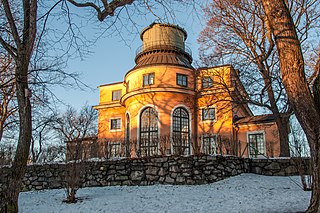
The Stockholm Observatory is an astronomical observatory and institution in Stockholm, Sweden, founded in the 18th century and today part of Stockholm University. In 1931, the new Stockholm Observatory, nicknamed "Saltis", was inaugurated on the Karlsbaderberget at Saltsjöbaden, near Stockholm, and operated until 2001.
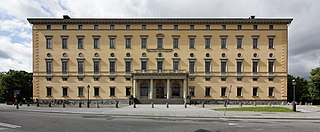
The Uppsala University Library at Uppsala University in Uppsala, Sweden, consists of 11 subject libraries, one of which is housed in the old main library building, Carolina Rediviva. The library holds books and periodicals, manuscripts, musical scores, pictures, and maps.
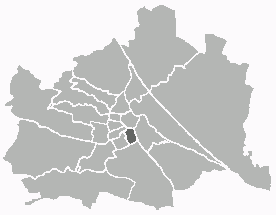
Wieden is the 4th municipal district of Vienna, Austria. It is near the centre of Vienna and was established as a district in 1850, but its borders were changed later. Wieden is a small region near the city centre. After World War II, Wieden was part of the Soviet sector of Vienna for 10 years.

Sophiahemmet University is a Swedish institution for higher education associated with Sophiahemmet. In addition to a degree in nursing, the institution also offers programmes at advanced level, such as Specialist Nursing programmes, as well as Bachelor, Master and Diploma programmes. Sophiahemmet Högskola has approximately 450 students enrolled in the three-year nursing programme and a total of approximately 1500 students on a yearly basis. Education is only offered in Swedish. Sophiahemmet University College was founded in 1884 by Queen Sophia.

Elisabeth Olin née Lillström was a Swedish opera singer and a music composer. She performed the leading female role in the inauguration performance of the Royal Swedish Opera in 1773, and is referred to as the first Swedish opera prima donna. She was the first female to be made Hovsångerska (1773), and the first woman to become a member of the Royal Swedish Academy of Music (1782).
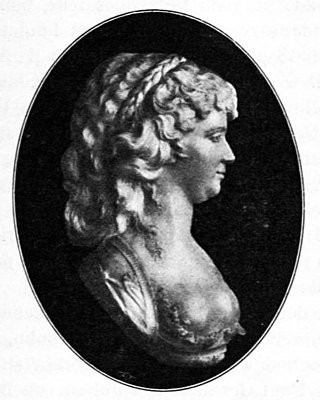
Sofia Franziska Stading was a Swedish opera singer of German origin. She is referred to as one of the more notable opera singers in Sweden during the Gustavian era. She was a Hovsångare and member of the Royal Swedish Academy of Music from 1788.

The Stockholm Music Museum was founded in 1899, inspired by an exhibition of theatre and music which was part of the great Stockholm art and industry exhibition of 1897. Via donations and appeals for gifts around 200 musical instruments and an amount of archive material concerning the history of music and theatre were gathered. The new museum was opened to the general public in 1901. In 1932 the museum, in the form of a trust, was associated with the Royal Swedish Academy of Music and received a state grant. The state became increasingly responsible for the museum, which in 1981 became part of a new public body–The Swedish National Collections of Music. At the same time the museum was renamed The Stockholm Music Museum (Musikmuseet), since its activities had broadened and changed in character. The present collection encompasses approximately 5,500 instruments with an emphasis on Western art music, and Scandinavian folk music instruments.
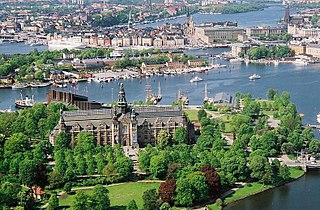
Djurgården or, more officially, Kungliga Djurgården, is an island in central Stockholm, Sweden. Djurgården is home to historical buildings and monuments, museums, galleries, the amusement park Gröna Lund, the open-air museum Skansen, the small residential area Djurgårdsstaden, yacht harbours, and extensive stretches of forest and meadows. It is one of the Stockholmers' favorite recreation areas and tourist destinations alike, attracting over 10 million visitors per year, of which some 5 million come to visit the museums and amusement park. The island belongs to the National City park founded in 1995. Since the 15th century the Swedish monarch has owned or held the right of disposition of Royal Djurgården. Today, this right is exercised by the Royal Djurgården Administration which is a part of the Royal Court of Sweden.

Rosendals Trädgård is a garden open to the public situated on Djurgården, west of Rosendal Palace, in the central part of Stockholm, Sweden. Today, Rosendals Trädgård is open to public visitors in order to let visitors experience nature and to demonstrate different cultural effects on gardening through history. The purpose is to practise biodynamic agriculture and pedagogical education. The garden is owned and operated by the trust fund "Rosendals Trädgårds Stiftelse". In the area known as Rosendals Trädgård there are also, except from the garden: "Plantboden", a gardening shop where the customers can find everything that's useful in a garden, "Trädgårdsbutik", a shop where the customers can buy fresh vegetables cultivated in the garden at Rosendal. The maybe most visited shop is the famous bakery, which carries the same name as the garden, "Rosendal Trädgårds bakery". Visiting Rosendals Trädgård, one has a great opportunity to experience locally cultivated and produced phenomena and items.

The Swedish National Museum of Science and Technology is a Swedish museum in Stockholm. It is Sweden’s largest museum of technology, and has a national charter to be responsible for preserving the Swedish cultural heritage related to technological and industrial history. Its galleries comprise around 10,000 square meters, and the museum attracts annually about 350,000 visitors. The collections consist of more than 55,000 objects and artifacts, 1 200 shelf metres of archival records and documents, 200,000 drawings, 800,000 images and about 40,000 books. The National Museum of Science and Technology also documents technologies, processes, stories and memoirs in order to preserve them for generations to come.

The Berlin Musical Instrument Museum is located at the Kulturforum on Tiergartenstraße in Berlin, Germany. The museum holds over 3,500 musical instruments from the 16th century onward and is one of the largest and most representative musical instrument collections in Germany. Objects include a portable harpsichord once owned by Prussia's Queen Sophie Charlotte, flutes from the collection of Frederick the Great, and Benjamin Franklin's glass harmonica.
Ferdinand Zellbell the Younger was a Swedish composer and a founding member of the Royal Swedish Academy of Music. He was organist at Storkyrkan, the main church of Stockholm, and chief conductor at Kungliga Hovkapellet. Arguably his most accomplished composition is an opera, Il Giudizio d'Aminta, written on the occasion of the birthday of future Empress Catherine the Great of Russia.

















